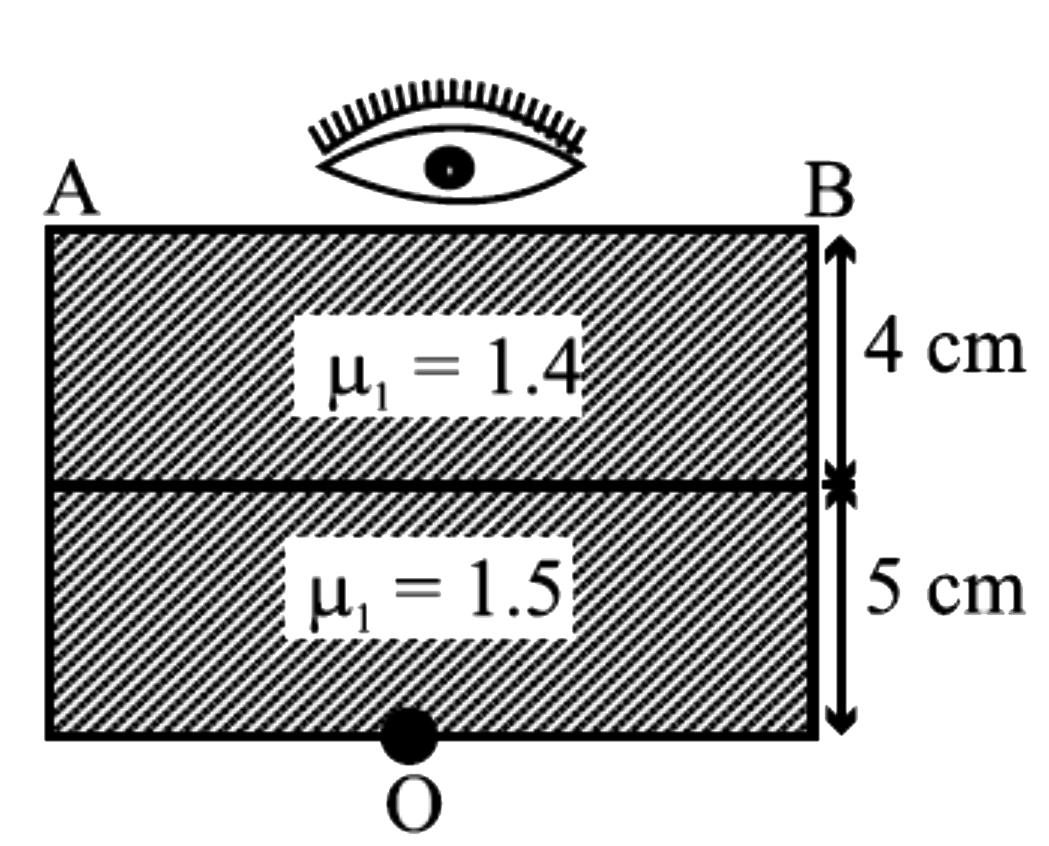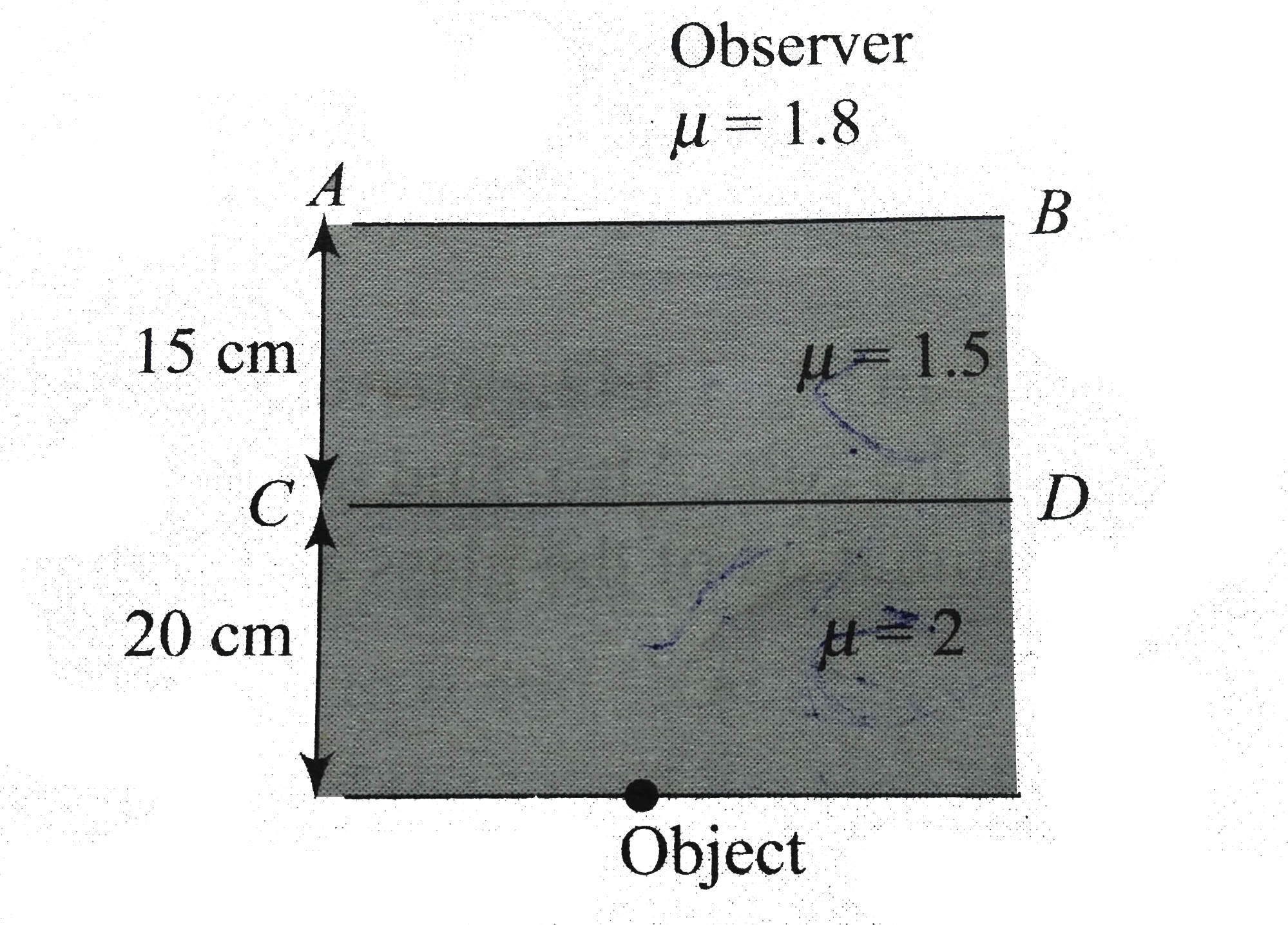A : The apparent depth of a tank of water decreases if viewed obliquely.
R : Real depth decreases if viewed obliquely.
If both Assertion & Reason are true and the reason is the correct explanation of the assertion, then mark (1).
If both Assertion & Reason are true but the reason is not the correct explanation of the assertion, then mark (2).
If Assertion is true statement but Reason is false, then mark (3).
If both Assertion and Reason are false statements, then mark (4).
The correct Answer is:C
To analyze the given assertion and reason, we will follow these steps:
Step 1: Understand the Assertion
The assertion states that "the apparent depth of a tank of water decreases if viewed obliquely." This means that when we look at a tank of water from an angle (rather than straight down), the depth that we perceive (apparent depth) seems to be less than the actual depth of the water.
Step 2: Understand the Reason
The reason states that "real depth decreases if viewed obliquely." Here, real depth refers to the actual physical depth of the water in the tank. We need to determine if viewing the tank obliquely actually changes the real depth.
Step 3: Analyze the Concept of Apparent Depth
When light passes from a denser medium (water) to a rarer medium (air), it bends away from the normal line. This bending of light causes the object (or the bottom of the tank) to appear higher than it actually is when viewed from an angle. This phenomenon is due to refraction.
Step 4: Draw a Diagram
To visualize this, we can draw a diagram:
- Draw a tank filled with water.
- Mark the real depth (hr) of the water.
- Draw rays coming from the bottom of the tank. One ray hits the water surface normally, while another hits at an angle.
- Show how the rays bend as they exit the water into the air.
Step 5: Conclusion on the Assertion
From our analysis, we can conclude that the assertion is true: the apparent depth decreases when viewed obliquely due to the refraction of light.
Step 6: Conclusion on the Reason
Now, regarding the reason: the real depth of the water does not change regardless of how we view it. The real depth remains constant, but the perceived (apparent) depth changes due to the bending of light.
Final Conclusion
Thus, we can conclude:
- The assertion is true.
- The reason is false.
The final answer is: Assertion (A) is true, and Reason (R) is false.
---
The assertion states that "the apparent depth of a tank of water decreases if viewed obliquely." This means that when we look at a tank of water from an angle (rather than straight down), the depth that we perceive (apparent depth) seems to be less than the actual depth of the water.
The reason states that "real depth decreases if viewed obliquely." Here, real depth refers to the actual physical depth of the water in the tank. We need to determine if viewing the tank obliquely actually changes the real depth.
When light passes from a denser medium (water) to a rarer medium (air), it bends away from the normal line. This bending of light causes the object (or the bottom of the tank) to appear higher than it actually is when viewed from an angle. This phenomenon is due to refraction.
To visualize this, we can draw a diagram:
- Draw a tank filled with water.
- Mark the real depth (hr) of the water.
- Draw rays coming from the bottom of the tank. One ray hits the water surface normally, while another hits at an angle.
- Show how the rays bend as they exit the water into the air.
From our analysis, we can conclude that the assertion is true: the apparent depth decreases when viewed obliquely due to the refraction of light.
Now, regarding the reason: the real depth of the water does not change regardless of how we view it. The real depth remains constant, but the perceived (apparent) depth changes due to the bending of light.
Thus, we can conclude:
- The assertion is true.
- The reason is false.
Topper's Solved these Questions
- RAY OPTICS AND OPTICAL INSTRUMENTSBOOK - AAKASH INSTITUTE ENGLISHCHAPTER - RAY OPTICS AND OPTICAL INSTRUMENTSEXERCISE - ASSIGNMENT (SECTION - C)
80 Videos
- PHYSICAL WORLDBOOK - AAKASH INSTITUTE ENGLISHCHAPTER - PHYSICAL WORLDEXERCISE - ASSIGNMENT (Section-B)
4 Videos
- SEMICONDUCTOR ELECTRONICS (MATERIAL, DEVICES AND SIMPLE CIRUITS )BOOK - AAKASH INSTITUTE ENGLISHCHAPTER - SEMICONDUCTOR ELECTRONICS (MATERIAL, DEVICES AND SIMPLE CIRUITS )EXERCISE - Assignment SECTION - D (Assertion & reason type Question)
10 Videos
Similar Questions
The apparent depth of an object O from AB is

View SolutionThe apparent depth of a liquid in a vessel is 15 cm, when its real depth is 20 cm. find the refractive index of the liquid.
View SolutionFind the apparent depth of object of the object seen by observe A (in the figure shown)

View SolutionA small object is placed at the centre of the bottom of a cylindrical vessel of radius 3 cm and height 4 cm filled completely with water. Consider the ray leaving the vessel through a corner. Suppose this ray and the ray along the axis of the vessel are used to trace the image. Find the apparent depth of the image and the ratio of real depth to the apparent depth under the assumptions taken. Refractive index -of water = 1-33.
View SolutionThe apparent depth of water in cylindrical water tank of diameter 2Rcm is reducing at the rate of xcm/min when water is being drained out at a constant rate. The amount of water drained in c.c. per minute is (n1= refractive index of air, n2= refractive index of water )
View SolutionThe apparent depth of water in cylindrical water tank of diameter 2Rcm is reducing at the rate of xcm/min when water is being drained out at a constant rate. The amount of water drained in c.c. per minute is (n1= refractive index of air, n2= refractive index of water )
View SolutionIn Fig. , find the apparent depth of the object seen below surface AB.

View SolutionThe apparent depth of ater in water in cylindrical water tank of diameter 2Rcm is reducing at the rate of xcm/min when is being drined out a constant rate. The amount of water drained in /min is (n1=refractive index of air, n2=refractive index of water)
View SolutionA tank filled with a liquid to a height of 12.5 cm. The apparent depth of a needle lying at the bottom of the tank is measured by a microscope to be 10 cm. If water is replaced by water of refractive index 1.66 up to the same height, by what distance (in mm) would the microscope have to be moved to focus on the needle again?
View SolutionA lift is accelerated upward Will the apparent weight of a person inside the lift increase , decrease or remain the same relative to its real weight ? If the lift is going with unifrom speed then ?
View Solution
